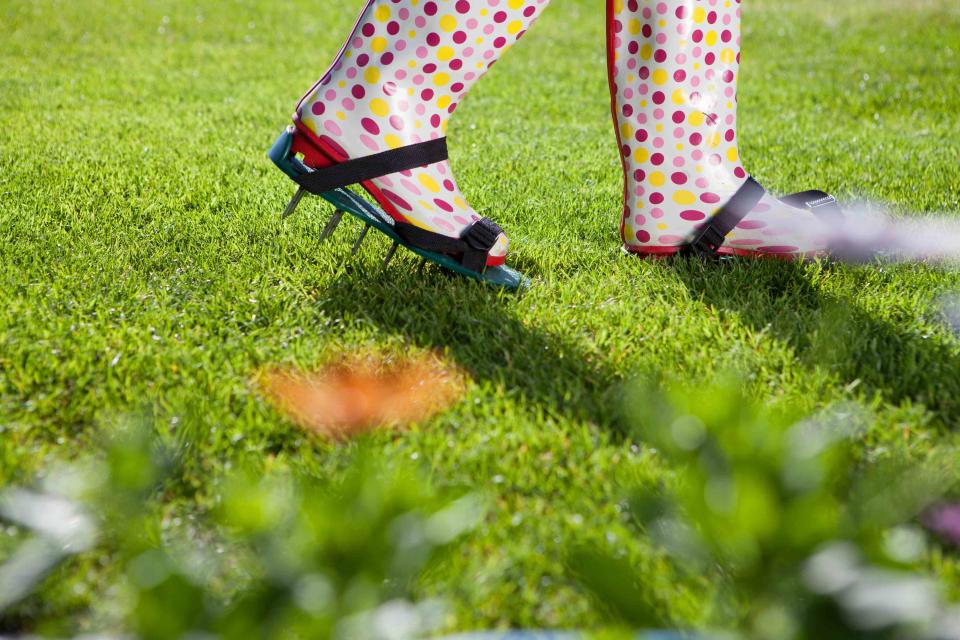Aerating Your Lawn: Everything You Should Know About this Landscape Game-Changer
Aeration could be the answer to your prayers for a healthier, greener lawn.

Nina Malyna/Getty Images
There are a lot of things you can do to beautify your lawn. You can give it a little edging action for a crisp border, routinely re-seed it for a fuller look, and treat it with a nice dose of fertilizer. Aerating your lawn is another option, and it’s a simple task that can make a world of difference in both the health and appearance of your lawn. We’re diving into what aerating is and why it’s important, and offering a step-by-step guide on how to aerate your lawn.
Related: Should You Resod or Reseed Your Lawn?
What Is Lawn Aeration?
Aeration is a process that loosens compacted soil in order to allow water, air, and nutrients to better access the roots. This is typically done with a mechanical core aerator that’s pushed over the lawn and leaves a trail of holes in its path.
“There are two main types of aerators: plug and spike,” says Justin Urbanek, product manager for John Deere Zero-Turn Mowers. “A plug aerator removes a core of soil and then deposits it on top of your lawn. A spike aerator punctures the ground providing a path for nutrients to access the roots.”
Urbanek argues that core aeration is more effective since it provides a larger path for nutrients. He says it also tends to break up compacted soil more effectively compared to spike aeration.
Why Is Aeration Important?
Over time, your lawn naturally becomes more compacted due to foot traffic, mowing, and other activities. In other words, the soil becomes denser and harder, which can impact the grass quality.
“Compaction seals off nutrients from the air, water, and fertilizer [and keeps it] from reaching the root zone of the plant,” explains Craig Elworthy, founder of Lawnbright. “Aeration decreases the soil density, and helps those nutrients reach the roots where they are untaken by the plant.”
Without aeration, your lawn can weaken and thin out over time. As another benefit, aeration helps reduce thatch buildup in your lawn. Thatch is a layer of dead root mass and dead grass that builds up over time and chokes off the lawn, which also robs it of water and nutrients.
“Aeration helps manage that buildup by pulling a core and depositing it on the top of the lawn surface where it can be swept up and removed, or allowed to be broken down by microorganisms,” Elworthy notes. The end result of aeration is a thicker lawn with a deeper, healthier root system.
Does My Lawn Need Aeration?
Aeration is obviously a game-changer for a wayward grass situation, but does every lawn require aeration? While most lawns can benefit from aeration, some need it more than others. Elworthy says that aeration is more important for clay soils that are prone to compaction.
“You can test for yourself if your soil is compacted by doing the screwdriver test,” Elworthy says. “Just find a screwdriver—preferably the largest one you have—and put it into the soil in a few places in your lawn. If it’s really difficult to get all the way down, your lawn could benefit from an aeration.”
When to Aerate Your Lawn
If you determine that your lawn needs aeration, Urbanek recommends doing it during peak growing season when your grass is already at its healthiest. This is typically in late spring or early fall. Urbanek says that your lawn will recover more quickly when it is not stressed from heat, drought, or winter freeze.
As for timing, Urbanek says that once a year is usually enough for most lawns. If your lawn is heavily compacted, then a twice-annual aeration may be beneficial. “For sandy soils or healthy lawns, every two to three years may be adequate,” he adds.
Step By Step: How to Aerate Your Lawn
Once you’ve got the right tools on hand, aerate your lawn is pretty straightforward. You’ll need a lawnmower and a core aerator. If you don’t own one, Urbanek says there are powered, walk-behind aerators you can rent from your local home improvement store. If you already own a riding lawnmower with a hitch, you can add a tow-behind aerator.
Step 1: Water Deeply One Week Out: “Starting a week or so out, start deeply watering your lawn,” Elworthy says. “The point of this is to help soften the soil to help with the aeration.”
Step 2: Mow Your Lawn: Mow your lawn the same day you plan to aerate. Elworthy recommends mowing an inch or two lower than you usually do and bagging all the clippings.
Step 3: Mark Obstacles: Take a moment to mark any sprinkler heads or electrical wiring so you can steer clear of these things when aerating. Urbanek says to also “mark shallow underground plumbing and utilities, stones, tree roots, or any other items so they can be avoided to avoid damage.”
Step 4: Aerate: Using your aerator attachment or device, go over the lawn in two to three different directions. “The more holes the better,” says Elworthy. Note that core aeration leaves cores of soil on the surface of your lawn. Leave these in place to break down and return nutrients to the surface of your yard.
Step 5: Fertilize (Optional) After aerating is a great time to apply a liquid fertilizer or sea kelp since your lawn is nice and open. This helps speed up the recovery and supercharges your results.
Related: The Best Time to Water Grass for a Greener Lawn—and Less Water Waste
For more Real Simple news, make sure to sign up for our newsletter!
Read the original article on Real Simple.

